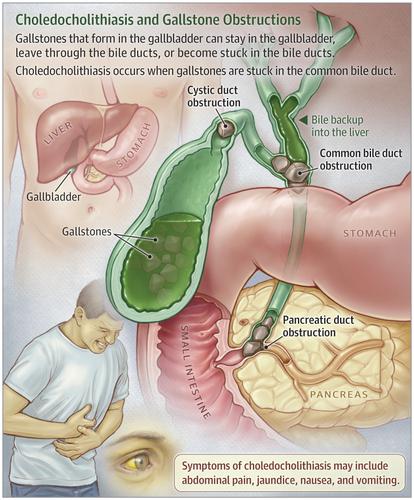JAMA ( IF 63.1 ) Pub Date : 2018-10-09 , DOI: 10.1001/jama.2018.11812 Ioana Baiu , Mary T. Hawn

|
Choledocholithiasis occurs when a gallstone blocks the common bile duct and bile cannot flow past it, instead backing up into the liver.
The gallbladder is a pouch the size of a lime that sits under the liver and stores bile. Bile is produced by the liver and helps with digestion of fat. Sometimes the cholesterol in bile can deposit and form thick crystals (sludge) or stones (gallstones). These stones can get stuck in the gallbladder, in the duct that goes from the gallbladder to the large bile duct (cystic duct), or in the large duct that goes from the liver and gallbladder to the bowel (common bile duct).
Patients often have right-sided abdominal pain and may have yellowing of the skin or eyes (jaundice). Patients may also experience clay-colored stools and dark urine. If the stone is stuck in the common bile duct in such a way that the enzymes from the pancreas also cannot flow to the small intestine, it can lead to gallstone pancreatitis, which can cause right, middle, and left upper abdominal pain; nausea; and vomiting. If the gallbladder becomes inflamed, it can lead to acute cholecystitis. If there is an infection of the ducts through which the bile flows, it leads to cholangitis. Both of these can cause right-sided abdominal pain, nausea, vomiting, and fever.
中文翻译:

胆石症
当胆结石阻塞了胆总管并且胆汁不能流经胆汁而倒退到肝脏时,就会发生胆管结石症。
在胆囊是一个小袋,根据肝和胆店位于石灰的大小。胆汁是由肝脏产生的,有助于脂肪的消化。胆汁中的胆固醇有时会沉积并形成厚的晶体(淤泥)或结石(胆结石)。这些结石可能会卡在胆囊中,从胆囊到大胆管的管道(胆囊管)或从肝脏,胆囊到肠的大管道(胆总管)中。
患者常会出现右侧腹痛,并可能皮肤或眼睛发黄(黄疸)。患者还可能会遇到黏土色的粪便和深色的尿液。如果结石以某种方式粘在胆总管中,使得来自胰腺的酶也无法流到小肠,则可能导致胆结石性胰腺炎,从而可能导致右,中和左上腹痛;恶心; 和呕吐。如果胆囊发炎,则可能导致急性胆囊炎。如果胆汁流经的导管受到感染,则会导致胆管炎。这两种情况都会导致右侧腹痛,恶心,呕吐和发烧。


















































 京公网安备 11010802027423号
京公网安备 11010802027423号